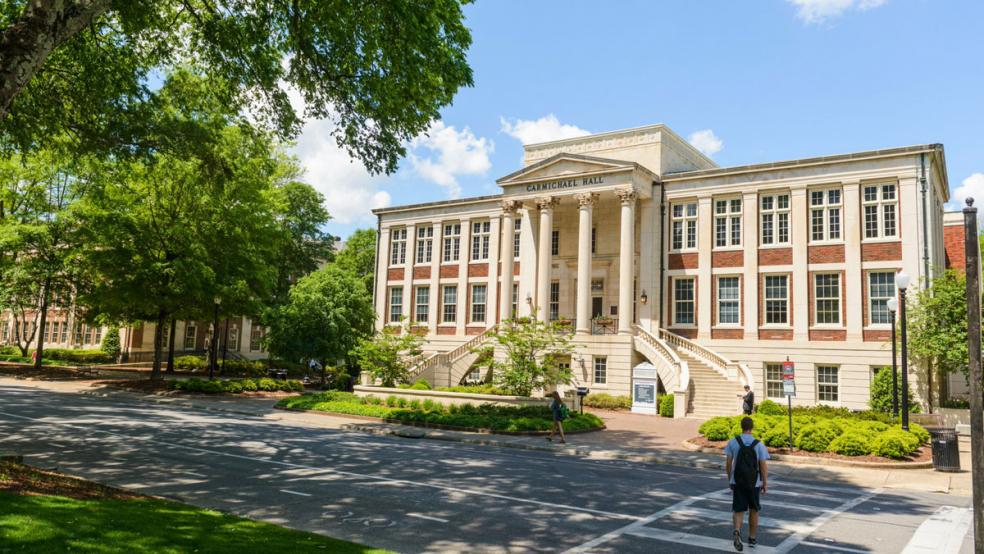A college education has always been described as an investment in the future – for students, and more broadly, for American society. Parents and students alike have already begun questioning the value of that investment from the former perspective, thanks to a massive student debt crisis that threatens the future of graduates. What kind of a degree is worth six figures of debt that might take decades to pay off?
A new study from Brookings ponders the value of the investment as a public policy question. Do public universities provide value over and above the costs that they accrue? Richard Reeves and Dimitrios Halikias argue that the investment may be misdirected – not because of the education provided, but because public colleges and universities disproportionally benefit the upper middle class.
Related: Rising Student Debt Locks Out Millennials From Home Ownership
That may seem like a curious conclusion. One would assume that an education provides equal benefit to those who acquire it from the same institution and in the same discipline and that the effort to provide that education benefits society equally by producing educated adults who are better prepared to raise their standard of living. On that basis, those students from a more modest background who get the same education as upper middle-class students would have more potential to move up the economic ladder afterward.
For most people, the education is the primary good of higher education. Reeves and Halikias admit that public funding might be a good investment on that basis, but they would rather “restrict our focus to the two most celebrated purposes of the American public university system: serving as engines of social mobility and producing world-class research.” With that in mind, Brookings focuses on social mobility in terms of getting into these schools and unsurprisingly concludes that the incredibly expensive public higher-education industry tends to have a distribution of consumers that skews to the higher end of the income spectrum.
While both social mobility and research might qualify as desirable secondary goods from universities and colleges, neither of those are the primary purpose for funding higher education at public institutions. For that matter, neither social mobility nor research is the exclusive province of higher education. An argument could be made that both could be achieved with far lower investment in public funds than that required to maintain costly universities. Research grants could shift more toward private institutions, which would then expand employment opportunities and perhaps introduce more accountability into the use of that funding. Small business loans on a broader basis could boost social mobility much more directly – and could get better targeted with means-testing screening.
Related: The Value of a College Degree in One Simple Chart
That doesn’t negate the worthiness of the basic question asked by the study. Does the value of the primary good of public degree-granting post-secondary institutions – the education itself – make the public investment worthwhile?
To answer that, one must understand the scope of the investment. According to the most recent data from the National Center for Education Statistics (NCES), the costs have skyrocketed at precisely a moment where one would have expected a decline. Total expenditures in the 2007-8 school year, at the start of the Great Recession, were a little over $261 billion. By the 2013-14 academic year, expenditures nearly hit $324 billion, an increase of 24 percent. Expenditures at four-year public schools rose 25.3 percent in the same six-year period.
Did that improve the education delivered by these schools, and therefore improve the prospects for their students? Not exactly, as the Federal Bank of New York discovered in a new study (an example, by the way, of research performed outside the university system). Between 2001 and 2009, public college tuition rose eighty-one percent during this period and contributed significantly to the debt crisis faced by college students.
That debt load contributed as much as a third of “the observed approximate eight-percentage-point decline in homeownership for 28-to-30-year-olds over 2007-15 for these same nine cohorts.” The NY Fed predicts “weaker spending and wealth accumulation among young consumers in the years to come,” not exactly an encouraging sign for social mobility.
Related: US Colleges Raise a Record $41 Billion, So Why Is Tuition Still Climbing?
With that context, it’s also easy to see why students from higher-income households are disproportionally represented. The family income allows those students more opportunity to buffer those effects after graduation, at least to some extent. For those of more modest means, the education may not generate enough income in practice to keep up with the debt it requires, even though they may be eligible for more public subsidies and grants because of their income status.
Some question whether students get an education at all or just indoctrination. Last month, Inside Higher Ed’s Scott Jaschik reported that education counselors have increasingly had to work with parents who balk at some colleges over their political and cultural environments. In some cases, the concern may be overblown, but in other cases, it is well earned.
The 2015 protests and attempts to shut down criticism of them at the University of Missouri put the school in the national spotlight, and the enrollment stats show a market response to its radicalism. Freshman enrollments have dropped 35 percent over the last two years, The New York Times reported last week, forcing the school to close seven dormitories and cut over 400 jobs from its main Columbia campus.
Related: The Hardest College to Get Into in the US
Nor is that the only indicator of a problem. The NCES also reported that the number of aid-eligible colleges and universities had declined four straight years, with the largest drop taking place over the past years (5 percent). From its peak in the 2012-13 school year, the number of aid-eligible schools has fallen almost nine percent. Many of these missing schools were for-profit private institutions, but the number of aid-eligible public schools – which receive the “subsidies” highlighted in the Brookings study – has also declined almost three percent from the peak in 2010-11.
Clearly, not as many people see investment in public universities as a wise choice, either for students or for society, and it’s not difficult to see why. Perhaps more focus on the education, rather than social mobility or cultural indoctrination, might improve higher education’s outlook.






